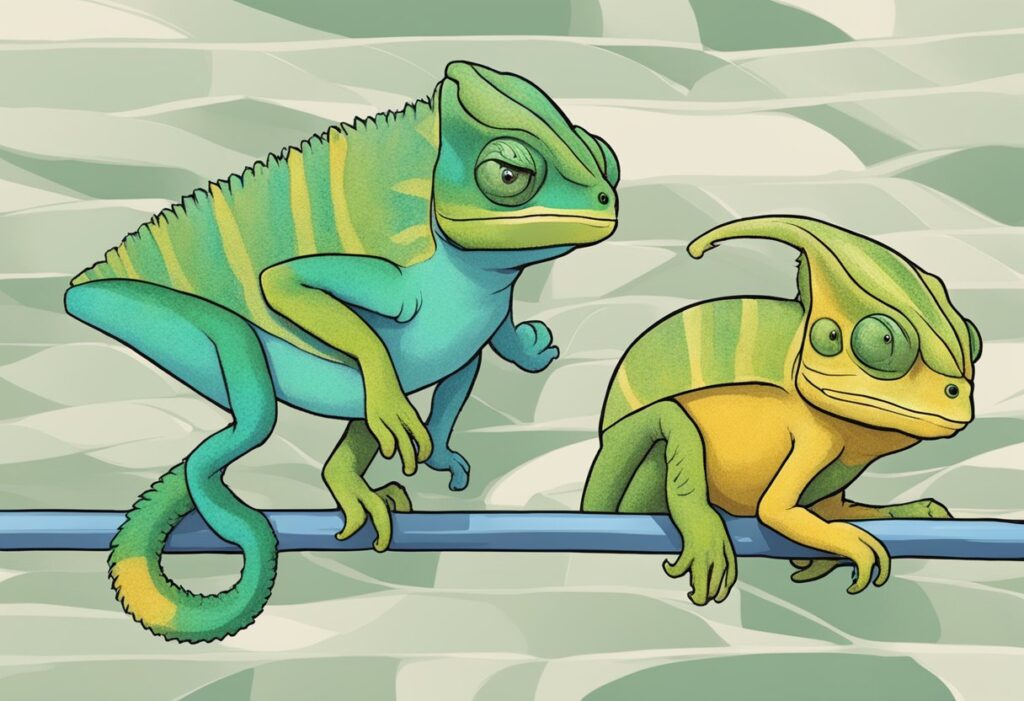Do chameleons like to be held?
If you’re a chameleon owner, you might be wondering whether your pet enjoys being handled or not. Unfortunately, the answer is not straightforward. While some chameleons can develop a tolerance for handling, most of them do not like to be held or petted.

Chameleons are fascinating creatures that are best observed from afar. They are intelligent and can recognize their owners, but they are not like dogs or cats that enjoy being petted or held. In fact, handling a chameleon can cause them stress and discomfort, which can lead to health problems.
If you’re considering getting a chameleon as a pet, it’s important to understand that they are not like other pets. They are solitary creatures that prefer to be left alone most of the time. While you can interact with your chameleon by feeding them or observing them, you should avoid handling them unless it’s necessary (such as for health checkups). By respecting your chameleon’s boundaries, you can ensure that they live a healthy and happy life.
Understanding Chameleon Behavior

Chameleons are fascinating creatures with unique characteristics that make them stand out from other reptiles. Understanding their behavior is crucial to providing them with proper care and handling. In this section, we will explore some of the key aspects of chameleon behavior that you should be aware of.
Stress and Fear Indicators
Chameleons are sensitive creatures that can easily become stressed or frightened. Some common stress and fear indicators to look out for include hissing, puffing up their body, and turning black. If your chameleon is displaying any of these behaviors, it is best to give them some space and observe them from a distance.
Interactions with Humans
Chameleons can form a bond with their owners over time, but it is important to approach them cautiously and with respect. They are territorial creatures and may become defensive if they feel threatened. When handling chameleons, it is best to start by letting them come to you and make the first move. Avoid approaching them from above, and do not try to pet or stroke them right away.
Chameleon Body Language
Chameleons communicate through body language, and it is important to understand what they are trying to tell you. If your chameleon is uncomfortable or feels threatened, they may turn black, hiss, or even bite. On the other hand, if they are relaxed and comfortable, they may be more open to being handled. When handling chameleons, it is important to be gentle and to respect their boundaries.
-

Beaded Dragon Fan Exclusive: ‘Original Hipster’ T-Shirt – Wear Your Unique Style with Pride – Unisex t-shirt
£13.00 – £20.50 Select options This product has multiple variants. The options may be chosen on the product page -

Chinese Water Dragon Aquatic Mastery Tee: Dive into Elegance with Our Exclusive Reptile Enthusiast Shirt – Unisex t-shirt
£13.00 – £20.50 Select options This product has multiple variants. The options may be chosen on the product page
In summary, chameleons can be delicate creatures that require careful handling and observation. By understanding their body language and behavior, you can build a trusting relationship with your chameleon and provide them with the care they need to thrive.
Chameleon Care
Chameleons are delicate animals that require proper care to thrive in captivity. In this section, we will discuss the essentials of chameleon care, including proper handling techniques, creating a comfortable habitat, and health and diet requirements.
Proper Handling Techniques
Chameleons are solitary creatures and can be shy and easily frightened. It’s important to move slowly and avoid sudden movements when handling them. When picking up a chameleon, it’s best to approach them from the side and scoop them up gently with both hands. Avoid grabbing them by the tail or limbs, as this can cause injury.
Chameleons have delicate skin and can be easily agitated. It’s important to reduce stress by handling them as little as possible. While some chameleons may tolerate being held, it’s generally best to observe them in their habitat rather than holding them.
Creating a Comfortable Habitat
Chameleons are arboreal and require a tall tank with plenty of climbing branches and foliage. A terrarium with a screen top is ideal for ventilation and to prevent predators from accessing your pet. It’s important to maintain a temperature gradient in the tank, with a basking area of 85-95°F and a cooler area of 72-80°F. At night, the temperature can drop to 70-75°F.
Humidity can be achieved by misting the tank several times a day and providing a water source for drinking and bathing. It’s important to clean the tank regularly to prevent illness and maintain a healthy environment for your pet.
Health and Diet Requirements
Chameleons require a diet of live insects, such as crickets, mealworms, and waxworms. It’s important to provide appropriate food and water to ensure your pet remains healthy. Some chameleons may also benefit from hand-feeding to reduce stress and provide socialization.
Chameleons are prone to health issues, such as respiratory infections and parasites. It’s important to monitor your pet for signs of illness, such as lethargy, lack of appetite, and difficulty breathing. If you suspect your pet is ill, it’s important to seek veterinary care immediately.
In conclusion, chameleons are delicate animals that require proper care to thrive in captivity. By following proper handling techniques, creating a comfortable habitat, and providing appropriate food and water, you can ensure your pet remains healthy and happy.
Building a Bond with Your Chameleon
If you have a chameleon as a pet, you may want to build a bond with it. While chameleons are not known for being affectionate like dogs or cats, it is still possible to create a comfortable and trusting relationship with your chameleon. Here are some tips to help you build a bond with your chameleon:
Be Gentle
Chameleons are delicate creatures that can easily become stressed or injured. When handling your chameleon, always be gentle and move slowly. Avoid sudden movements or loud noises that could startle your pet.
Be Patient
Building a bond with your chameleon takes time and patience. It is important to spend time near your chameleon’s enclosure, talking softly to them and offering treats like mealworms or dubia roaches. Over time, your chameleon will become more comfortable with your presence and may even come to recognize you as a source of food and comfort.
Don’t Force It
Chameleons do not like to be held or handled, so it is important to respect your pet’s boundaries. If your chameleon seems uncomfortable or stressed, do not force them to interact with you. Instead, try offering treats or simply spending time near their enclosure.
Provide Comfort
Creating a comfortable and secure environment for your chameleon is key to building a strong bond. Make sure their enclosure is the right size and has plenty of hiding spots and climbing opportunities. Keeping the enclosure clean and providing proper lighting and temperature control can also help your chameleon feel safe and at ease.
Build Trust
One of the best ways to build a bond with your chameleon is to build trust. Offer treats by hand, talk to them softly, and move slowly and gently when handling. Over time, your chameleon will learn to trust you and may even approach you on their own.
In summary, building a bond with your chameleon takes time, patience, and respect for your pet’s boundaries. You can create a strong and trusting relationship with your chameleon by being gently patient and providing a comfortable environment.

